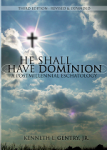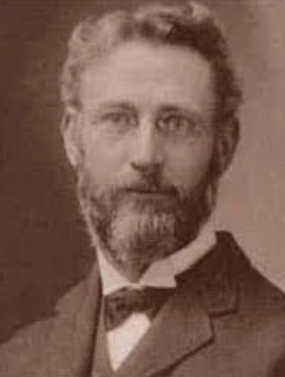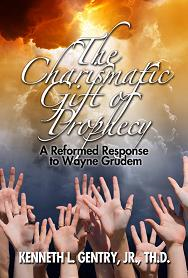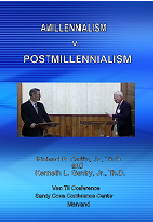PMW 2024-050 by Kenneth L. Gentry, Jr.
I am now at the conclusion of Matthew’s Gospel. Though I did not survey the entire Gospel, I showed it’s beginning and ending provided the rationale for the destruction of the temple and the judgment of Israel. And in the process of Israel’s rejecting their Messiah, we have seen evidence for the inclusion of the Gentiles. This last point comes to full expression in the last words of the Gospel.
Matthew 27
In Matthew 27:1 “all the chief priests” discuss with the “elders of the people” how to kill Jesus. In verses 11–12 Jesus appears before the Roman procurator Pilate where the chief priests and elders accuse him. In verses 15–21 when Pilate tries to release Jesus, the chief priests resist him: “but the chief priests and the elders persuaded the multitudes to ask for Barabbas, and to put Jesus to death” (v. 20). When Pilate attempts again to release him, “they kept shouting all the more, saying, ‘Let Him be crucified’” (v. 22).
Finally, Pilate declares himself innocent of Christ’s blood (Matt. 27: 24). Then we read: “And all the people answered and said, ‘His blood be on us and on our children!’” (v. 25). Their self-condemnatory cry eventually comes to pass with the destruction of Jerusalem in AD 70.

Standard Bearer: Festschrift for Greg Bahnsen (ed. by Steve Schlissel)
Includes two chapters by Gentry on Revelation and theonomy. Also chapters on apologetics, politics, ecclesiology, covenant, and more.
See more study materials at: www.KennethGentry.com
Then while the Lord is dying on the cross, the people and the leaders mock him one last time:
“And those passing by were hurling abuse at Him, wagging their heads, and saying, “You who are going to destroy the temple and rebuild it in three days, save Yourself! If You are the Son of God, come down from the cross.” In the same way the chief priests also, along with the scribes and elders, were mocking Him, and saying, “He saved others; He cannot save Himself. He is the King of Israel; let Him now come down from the cross, and we shall believe in Him.” (Matt. 27:39–42)
Consequently, we once again see evidence of Gentile salvation in the very context of Jewish rejection of Christ. In Matthew 27:54 we read regarding the Roman guard at Jesus’ tomb: “Now the centurion, and those who were with him keeping guard over Jesus, when they saw the earthquake and the things that were happening, became very frightened and said, ‘Truly this was the Son of God!’”
Matthew 28
Here we come to the apostle’s final recorded events, which lead up to and include Jesus’ issuing the Great Commission. As Valabanski notes: “the final verses of Matthew’s Gospel cannot be interpreted in isolation. It is the Gospel in its entirety that gives content and depth to the word of the Risen Christ in Mt 28:18–20.” [1]

He Shall Have Dominion
(paperback by Kenneth Gentry)
A classic, thorough explanation and defense of postmillennialism (600+ pages). Complete with several chapters answering specific objections.
See more study materials at: www.KennethGentry.com
Interestingly in this regard, we have the last appearance of Jerusalem in the Gospel, which appearance “casts the city in a negative light.” [2] After the resurrection, the Jews guarding his grave (Matt. 28:11; cp. 27:65–66) “went into the city [Jerusalem] and told the chief priests” that Jesus had been resurrected (cp. vv. 2–6). Then these religious leaders quickly concoct a plan to deny the report of Jesus’ resurrection. They bribe the Roman guards who had been stationed at his tomb, directing them to claim that his disciples stole his body (vv. 12–15). This is another unique feature of Matthew’s Gospel, which provides further evidence that Matthew is intentionally showing the vehement resistance of Israel to Jesus.
Then as the Gospel closes, Jesus appears to his disciples and issues his Great Commission (Matt. 28:18–20)— still another unique feature of Matthew that underscores God’s judgment on Israel. In this Commission, Jesus commands his followers to take the gospel to “all nations” (28:19), rather than limiting their ministry to Israel — as he had previously done (10:16–17; 15:24; cp. Acts 1:8). As Brown and Roberts observe: “Matthew’s decision to conclude his Gospel by widening this [Matt. 10:5–6; 15:24] missional scope suggests that gentile inclusion and mission provide a significant message for his audience.” [3] He is turning from the Jews, who have rejected him (Matt. 21:43; 23:37; 27:20–25, 38–42), in order to reach out to all the nations (v. 19; cp. Luke 24:46–47).
In this context, the disciples leave Israel’s capital city, Jerusalem, where they have been since the “Triumphal Entry” at the beginning of Passion Week (Matt. 21:1; cp. 28:5–9). They go to Galilee (28:6, 10, 16), which is called in Scripture, “Galilee of the Gentiles” [i.e., “nations,” Gk., ethnon]” (Isa. 9:2; Matt. 4:15). This is where he began his ministry to Israel (Matt. 4:12–17), and is now where he will begin his ministry to the nations. Thus, “Matthew’s concluding reference to ‘all nations’ (v. 19) indicates that this centrifugal dynamism (going out from Jerusalem to Galilee) was designed to show the out-going nature of the gospel message.” [4]

Navigating the Book of Revelation (by Ken Gentry)
Technical studies on key issues in Revelation, including the seven-sealed scroll, the cast out temple, Jewish persecution of Christianity, the Babylonian Harlot, and more.
See more study materials at: www.KennethGentry.com
Jesus is no Jewish sage, focusing solely on Israel. Rather, he is the cosmic Lord of all nations, who is here permanently expanding his mission. So, he will not only judge Israel (Matt. 24:4–34; cp. 28–44; 22:1–14) but eventually “all the nations” (25:31–46). To this end, he now declares his universal authority (28:18; cp. 13:41–43, 47–50), universal mission (v. 19; cp. 21:42–43; 22:9–10), and universal presence (v. 20; cp. 18:20).
He entrusts his disciples with the sacrament of baptism in order to apply the name of the Triune God to the nations: “Go therefore and make disciples of all the nations, baptizing them in the name of the Father and the Son and the Holy Spirit” (Matt. 28:19). The Jews have rejected his identity as the Son of God, not only condemning him to death for it (26:63–66) but mocking him for it while he suffers on the cross (27:43) — even though the Gentile centurion recognizes that he is the Son of God (27:54).
The Reformed Eschatology of Geerhardus Vos
Ed. by Ken Gentry and Bill Boney
This collection of several key eschatological studies by the renowned theologian Geehardus Vos will be published in late Summer or early Fall 2024. We have modernized Vos’ grammar and syntax and updated his publications according to modern style conventions (shorter sentences and paragraphs).
For information on the upcoming Geerhardus Vos work, see:
https://axeheadpress.com/pages/coming-soon-vos
Surprisingly, Matthew’s Gospel closes with the resurrected Jesus still on earth, rather than with his ascending into heaven (cp. Luke 24:51). Bauer notes that this “leaves the culmination of his Gospel open-ended.” [5] And it throws great emphasis on Jesus’ closing words: “I am with you always, even to the end of the age” (Matt. 28:20). This declaration serves as an inclusio for the Gospel’s whole story of Jesus. [6] For at the announcement of his birth, the angel declares his name to be “Immanuel,” which means “God with us” (1:23). Here Jesus, as the Son of God (note the baptismal formula mentioning the Father and the Son, v. 19), declares that he will be “with you always” (v. 20). It also shows the Gentile-oriented goal of Matthew’s Gospel (see notes at the beginning of this chapter).
Notes
1. Vicky Balabanski, “Mission in Matthew against the Horizon of Matthew 24,” unpublished seminar paper of the Society of Biblical Literature Annual Meeting (Philadelphia, Nov. 2005), 1.
2. P. W. L. Walker, Jesus and the Holy City, 39.
3. Jeannine K. Brown and Kyle Roberts, Matthew (THNTC) (Grand Rapids: Eerdmans, 2018). 18.
4. Walker, Jesus and the Holy City, 39.
5. David Bauer, Structure of Matthew’s Gospel, 114.
6. For a full argument for this serving as an inclusio, see Bauer, Structure, ch. 8.
Click on the following images for more information on these studies:
 |
 |
 |


Leave a comment